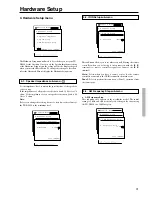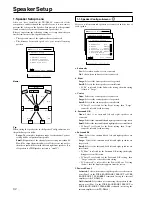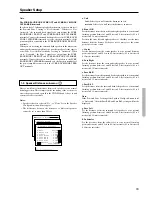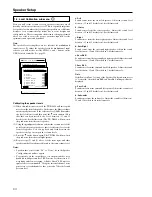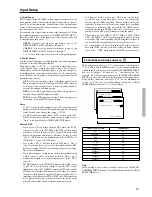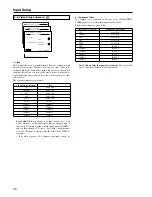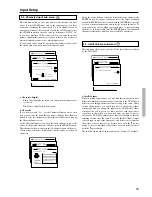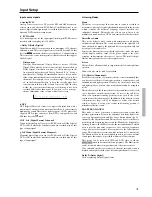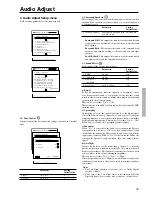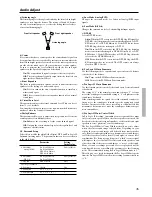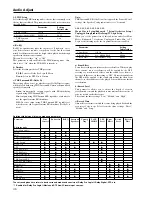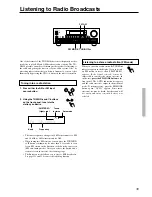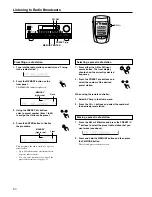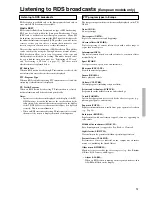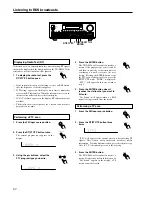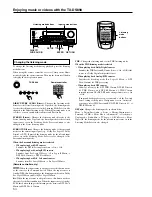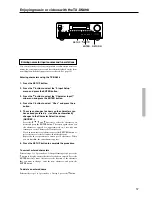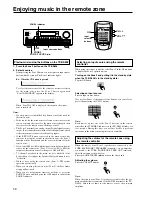
44
Audio Adjust
3-4. Delay
This sub-menu gives you various ways to adjust the timing of the
audio output from the speakers to give certain soundfield effects or
to adjust for unwanted asynchronous video and audio tracks.
This sub-menu does not appear if “Direct” is selected as the
listening mode.
Parameter
Setting
Initial value
a A/V Sync
0.0 ms to 74.0 ms
0.0 ms
Relative Delay
b Center
–4.0 ms to +6.0 ms
0.0 ms
c Surr L/R
–4.0 ms to +6.0 ms
0.0 ms
d Surr Back
–4.0 ms to +6.0 ms
0.0 ms
a. A/V Sync
If a digital signal processor is connected, there may be times when
the audio and video from a DVD or LD player is not output in perfect
sync. The result is where the sound and picture do not match and the
sound is heard too early. In such a case, use this setting to properly
synchronize the audio and video. This setting can be set between 0 to
74.0 ms in 0.5-ms increments. Under normal circumstances, this can
left at 0 ms. If set between 25.0 and 74.0 ms, upsampling is fixed to
24.0 ms. For input sources using the multi channel port, this setting
will not appear.
Relative Delay
b. Center, c. Surr L/R, d. Surr Back
Besides level and delay adjustments, the TX-DS898 provides the
ability to change or adjust the relative speaker position to fine tune
the soundfield for the listener. This is accomplished using Onkyo’s
unique Enhanced Spatial Positioning Algorithm. This adjustment
provides 10 milliseconds of delay for the speakers, which is
equivalent to moving the speaker 10 feet away. This adjustment is
set up to provide –4.0 or +6.0 milliseconds (–4 or +6 feet) of
adjustment to the listener’s position.
Once the coarse adjustments--speaker level and distance
adjustments--are made, the system is set up to provide a typical or
broad surround environment. By adjusting the relative position of
the speakers, we are able to alter the soundfield to be more spread out
(deeper) or focused (shallower).
Note:
Surr Back will not appear if the Powered Zone 2 setting of the
Speaker Config sub-menu is set to “Activated.”
3-5. LFE Level Setup
This sub-menu is for setting the LFE (Low Frequency Effect) levels
included in Dolby Digital and DTS software.
Parameter
Setting
Initial value
a Dolby Digital
–
∞
, –10 dB to 0 dB
0 dB
b DTS
–
∞
, –10 dB to 0 dB
0 dB
a. Dolby Digital
The level can be adjusted to either –
∞
or between –10 to 0 decibels in
1-decibel increments. For Dolby Digital input source signals, the
LFE level becomes that set here. A setting of 0 decibels is
recommended for optimum performance; however, if the low
frequency range is too strong, lower this setting as necessary.
b. DTS
The level can be adjusted to either –
∞
or between –10 to 0 decibels in
1-decibel increments. For DTS input source signals, the LFE level
becomes that set here. A setting of 0 decibels is recommended for
optimum performance; however, if the low frequency range is too
strong, lower this setting as necessary.
3-6. Mono Setup
The settings shown below are enabled when the listening mode is set
to “Mono.”
Parameter
Setting
Initial value
a Academy
On, Off
Off
b Input Channel
Auto L+R, Left, Right
Auto L+R
a) Academy
Older monaural film mixes relied on high-frequency rolloff in
presentation to sound properly balanced, so that excessive hiss from
the grain structure of the film would not be heard. The high-
frequency loss was typically due to a combination of optical slit loss,
electrical filters, loudspeaker response, and screen loss. Some films
have been transferred to video without such a high-frequency rolloff,
and thus sound overly bright and hissy. This unit includes this
“Academy filter,” which is based on contemporary playback
practices for such films over wide-range systems.
This can be set to either “On” or “Off.”
b) Input Channel
This allows you to set which input channel to use for monaural
sound.
Auto L+R: Select this under normal circumstances.
When the input source is center channel only, this channel is
used for monaural sound input channel. Otherwise, left and right
channels are mixed and the mixed signal is used for monaural
sound input channel.
Left/Right: You will need to select either left or right when
playing a video source that contains bilingual data. In such a
case, the left and right channels will contain different language.
Select the channel with the language you desire.
3-7. Theater Dimensional Setup
Select this to modify the Theater-Dimensional (T-D) listening
modes. The parameters that can be set are shown in the table below.
Parameter
Setting
Initial value
a Listening Angle
20 deg, 40 deg
20 deg
b Center
On, Off
Off
c Front Expander
On, Off
On
d Virtual Surr Level
–3 dB to +3 dB
0 dB
e Dialog Enhance
On, Off
Off
Theater Dimensional
For the best enjoyment of your home theater, it is recommended that
you have at least front left and right speakers, a center speaker, and
surround left and right speakers. However, if you only have front left
and right speakers, you can enjoy multichannel audio by using this
mode.
This mode controls the characteristics of the sound that reaches each
ear to reproduce a multi-speaker setup. To receive the full effect,
there is an optimum listening position (sweet spot). Refer to the
explanation of the listening angle. In addition, if the reflective sound
components are large, it may be difficult to achieve the desired
result, so be sure to set up your system and listening position to
minimize reflective sound.


